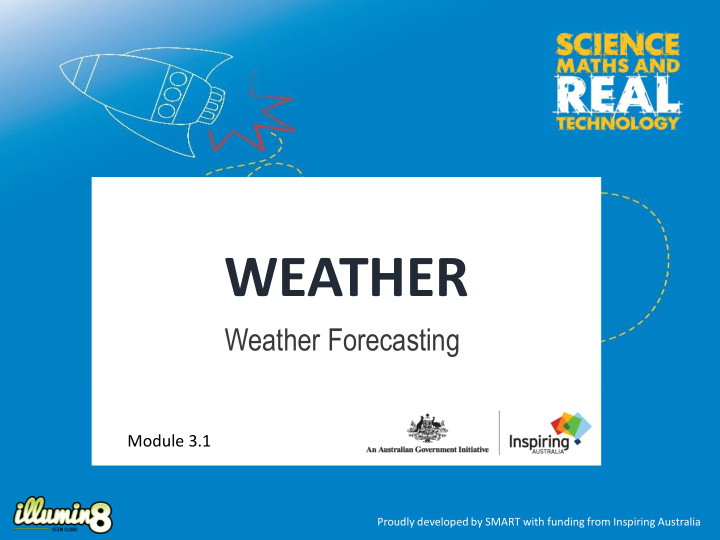



WEATHER Weather Forecasting Module 3.1 Proudly developed by SMART with funding from Inspiring Australia
Weather and Climate Image sources: pixabay.com
Earth’s Atmosphere has layers: EXOSPHERE Image source: http://www.srh.noaa.gov/jetstream/atmos/layers.htm
Cloud Formation Image source: http://schooltutoring.com/help/science-review-of-streams-and-the-water-cycle/
Aim: To observe air pressure change and cloud formation. Materials (demonstration): • Plastic soft-drink bottle • Liquid rubbing alcohol • Strong balloon / rubber • Duct tape • Air pump (balloon, foot or bike pump) Procedure: 1. Add a splash of rubbing alcohol to your plastic bottle and swirl it around to coat all the sides. 2. Tightly cover the top of your bottle using the balloon and duct tape. 3. Pierce a hole in the bottle cover, the same size of your pump nozzle. 4. Ensure the pump nozzle and hole in the balloon are as air tight as possible. 5. Pump air into the bottle till it becomes hard to pump. 6. Remove the pump nozzle as quickly as you can. 7. Observe. Repeat step 5, observe again. Image source SMART
Aim: To observe water condensation and cloud formation. Materials (per group): • Glass jar with lid • 150ml hot water • Food colouring (optional) • 3 to 5 cubes of ice • Aerosol Hairspray (shared between groups) Procedure: 1. Add food colouring to the hot water (optional) and pour into the jar. Fill to just under half-way. 2. Place the lid tightly onto the jar and swirl the hot water inside. 3. Quickly: Remove the lid, spray 1 squirt of hairspray into the jar, and replace the lid. 4. Place the jar onto the table and place the ice-cubes on top of the closed lid. 5. Observe. 6. Remove the ice-cubes, and the lid. Observe. Image source: http://coolscienceexperimentshq.com/make-a-cloud-form-in-a-jar/
The ten main types of cloud https://youtu.be/3WaAaMaQftg Video: What’s that Cloud? (Bureau of Meteorology) Image source: http://media.bom.gov.au/social/blog/895/whats-that-cloud/
Precipitation: Rain, Hail, Snow! http://splash.abc.net.au/home#!/media/30177/how-do-you-know-when-rain-is-coming- Video: How do you know when rain is coming? Image sources: http://pixabay.com
Aim: To simulate rain falling from clouds. Materials (per group): • 2 clear cups or jars • 250ml water • Food colouring • Pipette or straw • Handful of shaving cream Procedure: 1. Pour water into cup 1, filling to approx. 3/4 full. 2. Pour remaining water into cup 2, add a few drops of food colouring. Stir. 3. Place a cloud of shaving cream onto the surface of the clear water in cup 1. 4. Using the pipette (or straw), add droplets of the coloured water to the top of the cloud. 5. Observe. Image sources: https://www.teachpreschool.org/2012/03/10/clouds-in-jars-and-on-the-table-top-too/ http://www.kidspot.com.au/things-to-do/activity-articles/rain-cloud-in-a-jar-science-experiment/news- story/15c6693d124b82a9b0a968efa4d76a03?
Measuring the Weather http://splash.abc.net.au/home#!/media/85668/weather-forecasting Video: How do we forecast the weather? Image source: pixabay.com
Measuring Rainfall Image sources: http://www.srh.noaa.gov/jetstream/global/precip.html http://www.bom.gov.au/australia/radar/about/using_radar_images.shtml
Measuring Air Pressure Image sources: http://www.wisegeek.org/what-is-a-barometer.htm https://extension.illinois.edu/treehouse/airpressure.cfm?Slide=1 http://www.wikihow.com/Read-a-Weather-Map#/Image:Read-a-Weather-Map-Step-2-Version-2.jpg
Aim: To observe the effect of atmospheric pressure Materials (per group): • Glass jar • 1 – 2 Balloons • Tea light candle • Water • Straw • BBQ lighter (long handle) or long matches Procedure: 1. Divide into groups and collect materials. 2. Partially fill a balloon with water, until it is a fraction too big to fit through the opening of the jar. Tie the balloon closed. 3. Place the water filled balloon onto the jar and observe, then remove. 4. Place the tea light candle into the bottom of the glass jar, and carefully light it. 5. Place the water-filled balloon onto top of the glass jar (with the lit candle inside). 6. Observe. Extension: Remove the balloon from the bottle, without popping it. (Hint: Use the straw) Image source SMART
Measuring Wind Speed & Direction Image source: pixabay.com
Weather Map: Synoptic Chart High pressure system : Clear, Low pressure sunny weather system : Cloudy, rainy weather Image source: http://weather.news.com.au/synoptic/ 8/10/17
The challenge is… to predict the weather for the next session! To do this you will need to: • Build three weather measurement devices! • Record weather observations over time!
Your Weather Station Devices Build 3 devices to help you predict the weather! Rain Gauge Weather Vane Barometer (Rainfall) (wind direction) (Air Pressure) Image source: http://enb110-clh-2012.blogspot.com.au/2012/10/lab-3-seasonality-and- homemade-barometer.html https://www.eduplace.com/rdg/gen_act/weather/direct.html
Building your Barometer Barometers measure changes in atmospheric pressure. This barometer uses a flexible balloon on a jar. Note: Attach the card to the jar, or wall behind the jar, not the straw! The straw must be free to move as the balloon contracts and expands due to changes in air pressure outside the jar. https://www.youtube.com/watch?v=ah8F-xmvB2k Video by HooplaKidzLab: Making a Barometer. Image source: http://easyscienceforkids.com/make-your-own-barometer/
Building your Weather Vane Weather vanes indicate which direction the wind is blowing! Wind direction Use a compass so the vane can be set up to indicate if the wind is blowing north, south, east or west. The tail fin must be bigger than the arrow fin. The wind will catch the arrow tail and cause the arrow to point in the direction the wind is coming from. Weather vane arrows always point toward the on-coming wind. Image sources: http://www.nsta.org/publications/news/story.aspx?id=40875 http://preservinghomebasics.com/2011/11/weather-crafts-for-children
Building your Rain Gauge Rain gauges provide a measure of the amount of rain falling in an area within a period of time. Measurements are usually in millimetres. Find a place outdoors to place your rain gauge that is not under cover (and not under a tree!). Image sources: http://theimaginationtree.com/2012/04/homemade-rain-gauge.html https://i.pinimg.com/736x/8f/76/23/8f762349563453059722cdaf6a372cf8--rain-gauge-meteorology.jpg
Recommend
More recommend